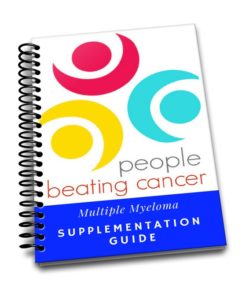
Recently Diagnosed or Relapsed? Stop Looking For a Miracle Cure, and Use Evidence-Based Therapies To Enhance Your Treatment and Prolong Your Remission
Multiple Myeloma an incurable disease, but I have spent the last 25 years in remission using a blend of conventional oncology and evidence-based nutrition, supplementation, and lifestyle therapies from peer-reviewed studies that your oncologist probably hasn't told you about.
Click the orange button to the right to learn more about what you can start doing today.
- You are here:
- Home »
- Blog »
- non-conventional therapies »
- Non-Toxic Myeloma- Intravenous Vitamin C, Curcumin
Non-Toxic Myeloma- Intravenous Vitamin C, Curcumin

PAA selectively kills CD138+MM tumor cells derived from MM and smoldering MM (SMM) but not from monoclonal gammopathy undetermined significance (MGUS) patients.
Hi David- I was wondering if intravenous vitamin C will keep me in remission after the ASCT transplant which I made back in 2014 for a multiple myeloma diagnosis earlier that year.
Presently the levels of Lambda are again increasing beyond the normal but they are not skyrocketing ….they are high but doctor said we can wait more before we start some treatment …presently lambda is 110 (maximum normal is 27).
I was wondering if there is a way I can stop the lambda from increasing before the doctor puts me on some treatment.
My oncologist requested one more blood test after a month from now and if the lambda showed higher he will then start some treatment.
Do you think the vitamin C injection if I start them from now , will they help decrease my lambda levels ?? Pls let me know the soonest? Thanks- Peter
Hi Peter,
I must begin my reply by saying that a remission of your MM from an autologous stem cell transplant in 2014 until now is a darn good remission. A six plus year remission is well-beyond the average.
My guess is that if your lambda light chains are slowly increasing, you are experiencing a biochemical relapse. See the article linked below.
Do you have any CRAB symptoms? You didn’t mention any so I’m thinking that you don’t.
I am wondering about your slow relapse because you may want to consider a couple of different therapy paths.
To answer your question, yes, intravenous vitamin C therapy has been shown to kill MM cells.
Further, you may want to consider other types of non-toxic nutrition supplements, like IVC, that have beeshown to fight MM. I will link the MM CC supplements guide below.
Assuming that you and your oncologist agree to eventually begin chemotherapy again someday, consider low-dose chemotherapy such as low-dose revlimid (lenalidomide) or low-dose velcade (bortezomib).
Undergoing low dose chemo means less chemo, less toxicity to you. Both Revlimid and Velcade integrate with several non-toxic therapies.
For example, Revlimid integrates with curcumin and Velcade integrates also with curcumin but also integrates with CBD oil.
The long-term advantage to you is that research has shown that low-dose therapies are easier on you and may allow you to manage your MM for years to come. Please read the study linked below.
To Learn More about intravenous vitamin C therapy and Myeloma- click now
Let me know if you have any questions. Good luck.
David Emerson
- MM Survivor
- MM Cancer Coach
- Director PeopleBeatingCancer
Recommended Reading:
- Multiple Myeloma Chemotherapy – Antioxidants Enhance Action
- Curcumin, Doxorubicin Combo in Relapsed/Refractory Multiple Myeloma
- Multiple Myeloma Stage 1- R,V,D Induction, I.V. Vit. C, Over-Diagnosis?
Management of multiple myeloma in the relapsed/refractory patient
“A biochemical relapse may require careful monthly monitoring of M-protein levels until significant progression occurs.
Treatment of biochemical relapse is indicated as follows: a doubling of serum M-protein, increase of serum M-protein by ≥10 g/L, increase of urine M-protein by ≥500 mg per 24 hours or an increase of involved serum-free light chains (FLC) level by ≥200 mg/L (plus abnormal ratio) by 2 measurements, 2 months apart. In high-risk patients, such as those with aggressive disease at diagnosis or a short treatment-free interval with a suboptimal response to previous treatment or imminent risk for organ dysfunction such as previous light chain-induced renal impairment or new bone lesions or adverse cytogenetics [t(4;14), del17p, or both], treatment should be initiated early after biochemical relapse is diagnosed to avoid serious symptomatic disease.3..”
Multiple Myeloma Tumor Cells are Selectively Killed by Pharmacologically-dosed Ascorbic Acid
“High-dose chemotherapies to treat multiple myeloma (MM) can be life-threatening due to toxicities to normal cells and there is a need to target only tumor cells and/or lower standard drug dosage without losing efficacy. We show that pharmacologically-dosed ascorbic acid (PAA), in the presence of iron, leads to the formation of highly reactive oxygen species (ROS) resulting in cell death.
PAA selectively kills CD138+MM tumor cells derived from MM and smoldering MM (SMM) but not from monoclonal gammopathy undetermined significance (MGUS) patients. PAA alone or in combination with melphalan inhibits tumor formation in MM xenograft mice. This study shows PAA efficacy on primary cancer cells and cell lines in vitro and in vivo.
Low-Dose Lenalidomide Is Effective and Less Toxic in Older Patients With Multiple Myeloma
TAKE-HOME MESSAGE
- In this prospective, multicenter study, 149 patients aged 59 years and older with multiple myeloma underwent attenuated doses of lenalidomide (15 mg) and dexamethasone (20 mg). When these patients were matched with a cohort of patients in another study receiving the standard dose, no difference was seen in progression-free survival and overall survival, and toxicity was reduced.
- Lenalidomide dose reduction can reduce adverse events without affecting survival outcomes.
Curcumin enhances the cytotoxic and chemo-sensitising effects of lenalidomide in human multiple myeloma cells
Background: Curcumin, the active component of the Curcuma longa plant, has been shown to potentiate the effect of the immunomodulatory drugs (IMiDs) thalidomide and Bortezomib against human myeloma cell lines and a nude mice model. Its effect on the other IMid, lenalidomide, has not been evaluated. This study aims to investigate the mechanism of action of curcumin and its potential ability to positively interact with lenalidomide.
Method: we designed an in-vitro study to investigate the cytotoxic and chemo-sensitising effects of curcumin alone and in combination with lenalidomide on the human myeloma H929 cell line.
Results: Incubation of H929 cells with curcumin (30mM) or lenalidomide (2.5 mM) for 3 days resulted in 26.35% (±1.06) and 30.81%(±2.98) apoptotic cells respectively. When 30 mM curcumin was combined with 2.5 mM lenalidomide, 50.4% (±3.37) apoptotic cells were detected by flow cytometry and the increase was significant compared to either curcumin alone or lenalidomide alone (anova p = 0.0026). Furthermore, gene analysis studies show that curcumin enhances the cytotoxic effect of lenalidomide via suppression of the cereblon and multi-drug resistant genes.
Conclusion: Curcumin exerts a cytotoxic effect additive to that of lenalidomide on H929 myeloma cells, and it also enhances the chemo-sensitizing effects of this agent.
The results of this small trial support further investigation of this novel drug for the treatment of patients with relapsed or refractory Multiple Myeloma.
Conventional oncology has gotten pretty good at putting newly diagnosed multiple myeloma into remission. If you are diagnosed at any stage of MM beyond the earliest of early MM, my experience is that your first priority is to get your MM under control.
Years or even months of conventional MM therapies will lead to common side effects such as CIPN, DVT’s, and others. Some side effects will heal some will not.
The ultimate challenge for the long-term MM survivor is to identify evidence-based, non-conventional therapies such as arsenic trioxide that can balance the toxicity, cost and collateral damage of conventional chemotherapies. Combined with evidence-based supplementation, nutrition, and integrative therapies you can manage your MM (as I have) for years.
I am both a MM survivor and MM cancer coach. Aggressive conventional MM therapies such as induction chemotherapy and an autologous stem cell transplant did little for me beyond giving me short, long-term and late-stage side effects. And my oncologist telling me that she could do nothing more for me after about 3 years…
MM management is not an either/or proposition. I have learned that long-term MMers must use the full spectrum of available MM therapies, both conventional and non-conventional.
Please watch the free webinar linked on the right of the page. Let me know if you have any questions or comments. I look forward to working with you.
Recommended Reading:
- Long-Term Multiple Myeloma Survivor- If I Knew Then What I Know Now
- Multiple Myeloma Chemotherapy – Antioxidants Enhance Action
- Relapsed/Refractory Multiple Myeloma- Patient Preferences
Arsenic trioxide potentiates sensitivity of multiple myeloma cells to lenalidomide by upregulating cereblon expression levels
“The present study revealed that low doses of arsenic trioxide potentiate the sensitivity of MM cell lines to lenalidomide by upregulating the expression of CRBN, the anti-myeloma target of lenalidomide. The results of the present study demonstrated that low doses of arsenic trioxide upregulated CRBN mRNA level in U266 and RPMI8226 cell lines…”
A Phase I Study of Arsenic Trioxide (Trisenox), Ascorbic Acid, and Bortezomib (Velcade) Combination Therapy in Patients with Relapsed/Refractory Mulitple Myeloma
“Results:
Of the patients that completed the treatment, objective responses were observed despite suboptimal dosing and previous bortezomib treatment failure. Tolerability was observed in most patients as discontinuation was not due to treatment toxicities, but due to aggressiveness of disease. Further studies are warranted with a larger patient population to effectively determine the effectiveness of AAV in relapsed/refractory multiple myeloma…”
Clinical activity of arsenic trioxide for the treatment of multiple myeloma.
“Arsenic has been used since ancient times as a therapeutic agent. However, until recently its use in modern medicine has been restricted to the treatment of a limited number of parasitic infections.
Investigations of this agent have demonstrated that its efficacy in APL and preclinical tumor models is dependent upon a number of mechanisms, including induction of apoptosis, effects on cellular differentiation, cell cycling, and tumor angiogenesis. Subsequent preclinical studies showed the significant activity of arsenic trioxide in multiple myeloma (MM).
Based on this, in a phase II trial, we have evaluated the activity of arsenic trioxide in 14 patients with relapsed MM, refractory to conventional salvage therapy. With the dose and schedule used, treatment with arsenic trioxide produced responses in three patients and prolonged stable disease in a fourth patient, with the longest response lasting 6 weeks. Although treatment was reasonably well tolerated, in these patients with extensive prior therapy, 11 developed cytopenia, five associated with infectious complications and three developed deep vein thromboses. The results of this small trial support further investigation of this novel drug for the treatment of patients with relapsed or refractory MM.”
Arsenic trioxide: new clinical experience with an old medication in hematologic malignancies.
“Arsenic trioxide has shown great promise in the treatment of patients with relapsed or refractory acute promyelocytic leukemia (APL). In clinical trials, arsenic trioxide induces complete remission in 87% of patients and molecular remission in 83% of patients. Two-year overall and relapse-free survival estimates are 63% and 49%, respectively. Treatment with arsenic trioxide may be associated with the APL differentiation syndrome, leukocytosis, and electrocardiographic abnormalities. The expanded use of arsenic trioxide in APL for postremission therapy, in conjunction with transplantation, and in patients with newly diagnosed APL is under investigation. The multiple mechanisms of action of arsenic trioxide suggest that it may have antitumor activity in malignancies other than APL and that it may be used in combination with other agents to expand its potential use.“



